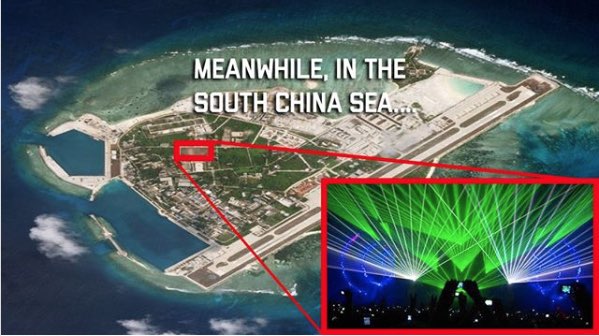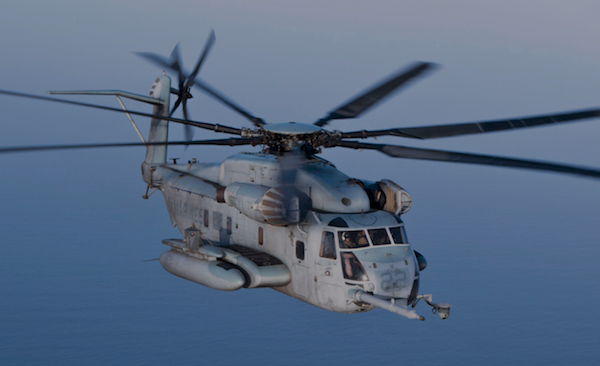Home
A comprehensive resource for safe and responsible laser use
US: Navy says China aimed invisible "military-grade" laser at Navy aircraft
28 Feb 2020 -- Categories: Aviation incidents | Updated story
The following is from a U.S. Pacific Fleet Public Affairs press release, posted February 27 2020:
A U.S. Navy P-8A Poseidon maritime patrol aircraft was lased by People’s Republic of China (PRC) navy destroyer 161 on Feb. 17 while flying in airspace above international waters approximately 380 miles west of Guam.
The P-8A was operating in international airspace in accordance with international rules and regulations. The PRC navy destroyer’s actions were unsafe and unprofessional.
Additionally, these acts violate the Code for Unplanned Encounters at Sea (CUES), a multilateral agreement reached at the 2014 Western Pacific Naval Symposium to reduce the chance of an incident at sea. CUES specifically addresses the use of lasers that could cause harm to personnel or damage to equipment. The destroyer’s actions were also inconsistent with a Memorandum of Understanding (MOU) between U.S. Department of Defense and the Ministry of National Defense of the PRC regarding rules of behavior for safety of air and maritime encounters.
The laser, which was not visible to the naked eye, was captured by a sensor onboard the P-8A. Weapons-grade lasers could potentially cause serious harm to aircrew and mariners, as well as ship and aircraft systems.
The P-8A is assigned to VP-45, based out of Jacksonville, Florida, and is forward-deployed to Kadena Air Force Base in Okinawa, Japan. The squadron conducts routine operations, maritime patrol and reconnaissance in the U.S. 7th Fleet area of operations.
U.S Navy aircraft routinely fly in the Philippine Sea and have done so for many years. U.S. Navy aircraft and ships will continue to fly, sail and operate anywhere international law allows.
U.S. 7th Fleet is the largest numbered fleet in the world, and with the help of 35 other maritime-nation allies and partners, the U.S. Navy has operated in the Indo-Pacific region for more than a century, providing credible, ready forces to help preserve peace and prevent conflict.
Thanks to Greg Makhov for bringing this to our attention.
UPDATE February 28 2020: The day after the above press release, the U.S. Navy posted a photo on its Instagram account showing an island and an inset rave light show.

The text of the Navy's post read:
"#ICYMI [in case you missed it] The Chinese Navy recently pointed a laser in an unsafe and unprofessional manner at a #USNavy P-8A flying in airspace above international waters. These acts violate the Code for Unplanned Encounters at Sea, a multilateral agreement reached at the 2014 Western Pacific Naval Symposium to reduce the chance of an incident at sea."
The laser aimed at the P-8A aircraft was from a destroyer, not an island. The beams were not visible to human eyes and of course, they were not from a laser light show.
From The Drive. Thank you to Leon McLin for bringing this update to our attention.
A U.S. Navy P-8A Poseidon maritime patrol aircraft was lased by People’s Republic of China (PRC) navy destroyer 161 on Feb. 17 while flying in airspace above international waters approximately 380 miles west of Guam.
The P-8A was operating in international airspace in accordance with international rules and regulations. The PRC navy destroyer’s actions were unsafe and unprofessional.
Additionally, these acts violate the Code for Unplanned Encounters at Sea (CUES), a multilateral agreement reached at the 2014 Western Pacific Naval Symposium to reduce the chance of an incident at sea. CUES specifically addresses the use of lasers that could cause harm to personnel or damage to equipment. The destroyer’s actions were also inconsistent with a Memorandum of Understanding (MOU) between U.S. Department of Defense and the Ministry of National Defense of the PRC regarding rules of behavior for safety of air and maritime encounters.
The laser, which was not visible to the naked eye, was captured by a sensor onboard the P-8A. Weapons-grade lasers could potentially cause serious harm to aircrew and mariners, as well as ship and aircraft systems.
The P-8A is assigned to VP-45, based out of Jacksonville, Florida, and is forward-deployed to Kadena Air Force Base in Okinawa, Japan. The squadron conducts routine operations, maritime patrol and reconnaissance in the U.S. 7th Fleet area of operations.
U.S Navy aircraft routinely fly in the Philippine Sea and have done so for many years. U.S. Navy aircraft and ships will continue to fly, sail and operate anywhere international law allows.
U.S. 7th Fleet is the largest numbered fleet in the world, and with the help of 35 other maritime-nation allies and partners, the U.S. Navy has operated in the Indo-Pacific region for more than a century, providing credible, ready forces to help preserve peace and prevent conflict.
Thanks to Greg Makhov for bringing this to our attention.
UPDATE February 28 2020: The day after the above press release, the U.S. Navy posted a photo on its Instagram account showing an island and an inset rave light show.

The text of the Navy's post read:
"#ICYMI [in case you missed it] The Chinese Navy recently pointed a laser in an unsafe and unprofessional manner at a #USNavy P-8A flying in airspace above international waters. These acts violate the Code for Unplanned Encounters at Sea, a multilateral agreement reached at the 2014 Western Pacific Naval Symposium to reduce the chance of an incident at sea."
The laser aimed at the P-8A aircraft was from a destroyer, not an island. The beams were not visible to human eyes and of course, they were not from a laser light show.
From The Drive. Thank you to Leon McLin for bringing this update to our attention.
US and Iran: UPDATED - Iranian naval ship shines laser on US helicopter says U.S.; Iran denies
An Iranian naval vessel aimed a “targeting laser” at a U.S. Marine Corps CH-53E helicopter on June 13 2017. This set off the helicopter’s automatic defense system, which fired flare signals.
A group of three U.S. ships — a destroyer, an amphibious assault ship, and a dry cargo ship — were transiting international waters in the Strait of Hormuz, according to a U.S. military statement. The Iranian naval vessel, said by one source to be a missile ship, came within 800 yards of the assault ship and scanned two of the U.S. ships with a spotlight.
The helicopter was flying alongside the deployment when the Iranian targeting laser was aimed at it, setting off the flares.
There was no report of injury to the helicopter pilots. A spokesperson for the U.S. Navy’s Fifth Fleet said “Illuminating helicopters with lasers at night is dangerous as it creates a navigational hazard that can impair vision and can be disorienting to pilots using night vision goggles.”
A group of three U.S. ships — a destroyer, an amphibious assault ship, and a dry cargo ship — were transiting international waters in the Strait of Hormuz, according to a U.S. military statement. The Iranian naval vessel, said by one source to be a missile ship, came within 800 yards of the assault ship and scanned two of the U.S. ships with a spotlight.
The helicopter was flying alongside the deployment when the Iranian targeting laser was aimed at it, setting off the flares.
There was no report of injury to the helicopter pilots. A spokesperson for the U.S. Navy’s Fifth Fleet said “Illuminating helicopters with lasers at night is dangerous as it creates a navigational hazard that can impair vision and can be disorienting to pilots using night vision goggles.”

Marine Corps Sikorsky CH-53E Super Stallion
From Newsweek and CNN
UPDATED JULY 16 2017 - Iran claimed it did not point a laser at the helicopter. The Tasnim News Agency said “A top commander of Iran’s Navy denied reports that the country’s naval forces had pointed a laser at an airborne US Marine Corps helicopter in the Strait of Hormuz back in June. Commander of Iran's First Naval Zone Admiral Hossein Azad categorically denied reports of such incident.”
The report had no additional details, such as what could have set off the helicopter’s flares as claimed by the initial U.S. report.
From the Tasnim News Agency and the Tehran Times
Australia: "Slight eye pain" for crew of helicopter targeted by teen
A 19-year-old Woollamia man will appear in Nowra (NSW) Local Court after being charged with shining a laser pointer at a navy helicopter from HMAS Albatross on October 30 2014.
It is alleged the man targeted a Seahawk helicopter from 816 Squadron as it was returning to HMAS Albatross after a training flight about 10.30pm. The high-powered laser was pointed at the aircraft for around a minute from the car park of the man’s workplace at South Nowra.
The helicopter landed safely, with the four crew members on board treated for slight eye pain.
Police from the Shoalhaven Local Area Command interviewed the pilot and co-pilot, who provided an approximate location of the beam’s origin. Police searched the area and located the 19-year-old man.
A laser pointer was seized by police and the man was issued with a future court attendance notice and is due to appear in Nowra Local Court on November 19.
From the South Coast Register
It is alleged the man targeted a Seahawk helicopter from 816 Squadron as it was returning to HMAS Albatross after a training flight about 10.30pm. The high-powered laser was pointed at the aircraft for around a minute from the car park of the man’s workplace at South Nowra.
The helicopter landed safely, with the four crew members on board treated for slight eye pain.
Police from the Shoalhaven Local Area Command interviewed the pilot and co-pilot, who provided an approximate location of the beam’s origin. Police searched the area and located the 19-year-old man.
A laser pointer was seized by police and the man was issued with a future court attendance notice and is due to appear in Nowra Local Court on November 19.
From the South Coast Register